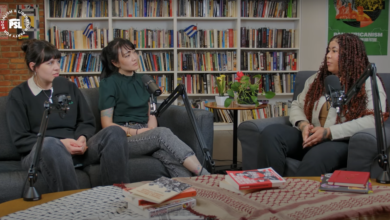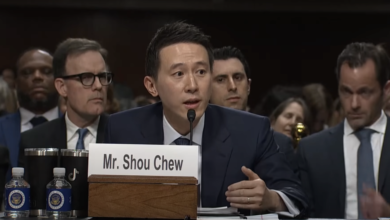 Ten thousand demonstrators outside of Madison Square Garden as Bush accepts Republican nomination in a protest initiated by the ANSWER Coalition. Photo: Bill Hackwell |
The eyes of the entire world were watching New York City in the days before and during the Republican National Convention. For seven straight days, people from across the U.S. and around the world poured into the streets for protests against every aspect of the Bush administration’s program. Protests targeted U.S. wars and occupations abroad and the Bush administration’s attacks on civil rights. Unions, women’s organizations, lesbian/gay/bisexual/transgendered rights groups, environmental activists-hundreds of organizations participated in organizing and publicizing the demonstrations, conferences and other events that took place.
For weeks before, the streets buzzed with sentiment against Bush and the Republican Party. The demonstrations clearly had the support of the vast majority of the people in New York. According to a Quinnipiac University poll, 81 percent of New Yorkers approved of legal demonstrations during the convention.
And true to expectations, hundreds of thousands of people took to the streets. The National Organization for Women brought out 25,000 to march across the Brooklyn Bridge in support of reproductive rights. Half a million came out on Aug. 29, the day before the convention opened. Forty thousand union workers, organized by the New York City Central Labor Council, demonstrated on Sept. 1.
Smaller, more militant actions took place throughout the week. Thousands of bicyclists staged a nighttime Critical Mass ride through lower Manhattan on Aug. 27, challenging cops trying to shut down the “protest on wheels.” Thousands came out in New York on Aug. 31, designated a day of direct action and civil disobedience.
Actions took place across the city-from Union Square, a historic center of protest, to Harlem and the Bronx.
On the final day of the convention, the ANSWER (Act Now to Stop War and End Racism) Coalition held an angry protest of 10,000 outside Madison Square Garden. It was more than an anti-Bush protest. It was against the war and occupation of Iraq. It was a conscious act of solidarity with thousands of Palestinian political prisoners who had been on a hunger strike against Israeli brutality. And it was a protest against U.S. occupations around the world, from Haiti to the Philippines.
The massive outpouring in New York City gave heart to people across the U.S. and around the world who were hoping for a clear manifestation of the anger and opposition that exists to the Bush administration’s pro-war and anti-working class program.
People vs. state
In the face of these massive protests, the entire state apparatus-the police, the armed forces, and the courts-along with the big business media united to make sure the protests did not have the impact of, say, the demonstrations against the 1968 Democratic Convention in Chicago or against the 1999 World Trade Organization meetings in Seattle.
The federal government opened a campaign of ‘terror alerts’ based on vague threats, forgotten after the convention ended. Local newspapers chimed in: “Police Intelligence Warning: Anarchy, Inc.,” blared the Aug. 26 Daily News front page. “Hard-core troublemakers a threat to Republican convention” was the warning to New York City’s working class not to turn out against the Republican convention.
Nor was the fear campaign restricted to traditional Republican Party allies. The Democratic Party establishment, along with the New York Times and other “liberal” media outlets, admonished demonstrators that militancy would end up helping the Bush electoral strategy.
On the legal front, federal and state courts alike upheld the city’s adamant refusal to open Central Park to any mass protests. This blatant suppression of free speech in an area that has hosted some of the biggest protests in the United States became a lightning rod of criticism, opening the eyes of millions to the openly political character of New York City’s system of issuing permits.
“They thought people would capitulate when the government attempted to ban mass protests from the Great Lawn in Central Park,” stated an ANSWER press release on Aug. 24. “Instead, people are resisting.” ANSWER and the National Council of Arab Americans sued the city for denying a permit for an Aug. 28 civil rights rally.
The lawsuit, which was filed by the Partnership for Civil Justice and the National Lawyers Guild, was a major factor in shifting the political climate in New York City and exposing the government’s efforts to prevent mass assembly protests during the RNC.
Throughout the convention, tens of thousands of police and National Guard troops were deployed against the demonstrations. Cops were armed with sophisticated weaponry. Armored personnel carriers patrolled the streets.
Civil disobedience was met by a wave of police force. At least 1,781 people were arrested in the course of the week. Some were beaten and pepper sprayed. Others had large orange nets thrown over them to capture them prior to being handcuffed.
Arrestees were held in brutal conditions, most in a makeshift holding area on Pier 57. Many became sick from the chemicals in the air and on the floors. Most were held in excess of 24 hours, in violation of New York City law. Activists charge that the arrests and delayed releases were a form of preventive detention, with police acting in tandem with RNC organizers to prevent militant mass demonstrations.
The massive display of force, along with the circling of media wagons around the RNC, reflected a fear on the part of the ruling class that mass anger would go beyond the bounds of a “loyal opposition” to the Bush administration. There is no split in the ruling class on the questions of subjugating the Iraqi people or enriching the biggest banks and corporations while further impoverishing the working class. Faced with the prospect of mass, militant challenges to these pillars of U.S. ruling class objectives, the state unleashed every possible means to diminish, pacify, or ultimately crush the hundreds of thousands who set out to challenge the war makers and other fat cats.
 Some hope to channel the power of the labor and anti-war movements into the Democratic Party. Photo: Bill Hackwell |
The role of leadership
In this tense atmosphere, the leaderships of various sectors of the antiwar, labor and progressive movement were put to the test for hundreds of thousands to see. What would be the reaction of the different political forces that claimed to challenge the Bush agenda?
The leaderships of most major unions are pouring vast resources into Kerry’s election campaign. Yet their Labor Day rally outside of Madison Square Garden offered little to the tens of thousands of union members who came out to fight.
“We are here today to peacefully petition President Bush to stop serving his corporate clients and their agenda, and to start paying attention to the everyday needs and priorities of working families,” intoned AFL-CIO President John Sweeney. Militant workers could only roll their eyes at Sweeney’s pleas to Bush, as they were herded toward the voting booths two months down the road.
United for Peace and Justice held the permits for the Aug. 29 demonstration the day before the convention. Although the whole antiwar movement mobilized for this action, UFPJ flyers for the demonstration downplayed the war. Instead, the main slogan for their flyers and posters was, “Say no to the Bush agenda.”
The leadership of UFPJ represents a particular segment of the U.S. antiwar movement that has tactical differences with the U.S. government but fundamentally supports their objectives at home and abroad. Before the war, it called for “disarming Iraq”-a continuation of many of the leaders’ calls before the first Gulf War for “sanctions, not war.” By including groups that explicitly call for U.S. “victory” in Iraq like Win Without War, the UFPJ leadership strives to find a political path that dovetails with the Democratic Party.
A clear and powerful antiwar message on Aug. 29 would have implicitly been anti-Kerry. Kerry fundamentally supports all of the imperialist objectives worldwide. He calls for a “winning strategy” in Iraq and does not endorse bringing the troops home now.
So instead, the UFPJ leadership made it clear that they would try to accommodate the desires of the Democrats for a tame, diffuse demonstration. This orientation could be seen in their cowardly negotiations with the New York Police Department: first accepting the NYPD’s demand for a rally on the isolated West Side Highway, then being forced by outrage in the antiwar movement to try to sue to gain access to Central Park, and finally agreeing to divert the march away from Central Park back to Union Square.
Not everyone agreed with that perspective. Thousands faced off against the cops on Aug. 31. But without a battle-tested leadership, the combined force of the state overwhelmed those militant but loosely organized protests.
The ANSWER Coalition, since its formation in the days after the Sept. 11 attacks, consistently aimed to provide an anti-imperialist perspective within the antiwar movement. Its leadership has been oriented away from the Democratic Party establishment and toward building a mass opposition to the “twin parties of the war machine.”
Throughout the week of protests, ANSWER’s slogans-“Bring the troops home now-End colonial occupation from Iraq to Palestine to Haiti and everywhere”-won widespread support. Ten thousand people responded to ANSWER’s call for a militant protest at Madison Square Garden as Bush spoke.
The two main poles within the antiwar movement-between accommodation to the Democratic Party on the one hand and militant anti-imperialism on the other-will provide a framework for the hundreds of thousands who are taking to the streets to learn political lessons in the heat of battle. As the war in Iraq continues to sharpen, more and more people-workers, students and soldiers-will go beyond trying to change this or that policy of whichever party controls the White House. Thousands want to struggle against the imperialist system.
Uniting all who want to carry out that struggle is the main challenge facing the antiwar movement today.





